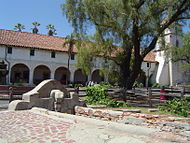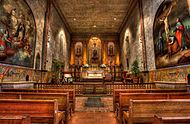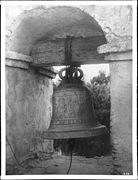Mission Santa Barbara
This article needs additional citations for verification. (January 2021) |
 The capilla (chapel) at Mission Santa Barbara. | |
 Location of Mission Santa Barbara in California | |
| Location | 2201 Laguna St. Santa Barbara, California 93105 |
|---|---|
| Name as founded | La Misión de La Señora Bárbara, Virgen y Mártir [1] |
| English translation | The Mission of the Lady Bárbara, Virgin and Martyr |
| Patron | Saint Barbara of Greece[2] |
| Nickname(s) | "Queen of the Missions" [3] |
| Founding date | December 4, 1786 [4] |
| Founding priest(s) | Father Fermín Lasuén [5] |
| Built | 1820, 1925 (repair) |
| Architect | Ripoll, Father Antonio |
| Architectural style(s) | Colonial, Other, Spanish colonial |
| Founding Order | Tenth mission [2] |
| Headquarters of the Alta California Mission System | 1833–1846 [6] |
| Military district | Second [7] |
| Native tribe(s) Spanish name(s) | Chumash Barbareño, Canaliño |
| Native place name(s) | Xana'yan [8] |
| Baptisms | 5,556 [9] |
| Marriages | 1,486 [9] |
| Burials | 3,936 [9] |
| Secularized | 1834 [2] |
| Returned to the Church | 1865 [2] |
| Governing body | Roman Catholic Archdiocese of Los Angeles |
| Current use | Parish Church |
U.S. National Register of Historic Places | |
| Designated | October 15, 1966[10] |
| Reference no. | 66000237[10] |
| Designated | October 9, 1960[11] |
| Reference no. |
|
| Website | |
| http://www.santabarbaramission.org | |
Mission Santa Barbara (Spanish: Misión de Santa Bárbara) is a Spanish mission in Santa Barbara, California. It was founded by Padre Fermín Lasuén for the Franciscan order on December 4, 1786, the feast day of Saint Barbara, as the tenth mission for the religious conversion of the indigenous local Chumash-Barbareño tribe of Native American people. The mission is the namesake of the city of Santa Barbara as well as of Santa Barbara County.
The Mission grounds occupy a rise between the Pacific Ocean and the Santa Ynez Mountains, and were consecrated by Father Fermín Lasuén, who had taken over the presidency of the California mission chain upon the death of Father Presidente Junípero Serra. Mission Santa Barbara is the only mission to remain under the leadership of the Franciscan Friars since its founding, and today is a parish church of the Archdiocese of Los Angeles.
History[]
Mission Santa Barbara's name comes from the legend of Saint Barbara, a girl who was beheaded by her father for following the Christian Faith. The early missionaries built three different chapels during the first few years, each larger than the previous one. After the significant damage from the Santa Barbara earthquake on December 21, 1812,[13] construction on the current Mission was begun. It was completed and dedicated in 1820. The towers were considerably damaged in the June 29, 1925 earthquake,[14] but were subsequently rebuilt by 1927.[15][16] The appearance of the inside of the church has not been altered significantly since 1820.

Many elements of the Mission's extensive water treatment system, all built by Chumash Indians' labor under the direction of the Franciscans (including aqueducts, two reservoirs, a filter house, and a hydro-powered gristmill) remain to this day. The larger reservoir, which was built in 1806 by the expedient of damming a canyon, had been a functioning component of the City's water system until 1993.[17] The original fountain and lavadero are also intact near the entrance to the Mission. A dam constructed in 1807 is situated in the current Santa Barbara Botanic Garden up "Mission Canyon". The ruins of the Mission's tanning vats, pottery kiln, aqueduct system, and guard house are located on the abutting land in the municipally-owned Mission Historical Park that was sold to the City in 1928.[18]

In 1818, two Argentine ships under the command of the French privateer Hipólito Bouchard approached the coast and threatened the young town of Santa Barbara. The padres armed and trained 150 of the neophytes to prepare for attack. With their help, the Presidio soldiers confronted Bouchard, who sailed out of the harbor without attacking.[19]
After the Mexican Congress passed An Act for the Secularization of the Missions of California on August 17, 1833 Father Presidente Narciso Durán transferred the missions' headquarters to Santa Barbara, thereby making Mission Santa Barbara the repository of some 3,000 original documents that had been scattered through the California missions.
The Santa Barbara Mission-Archive Library is now an independent non-profit educational and research institution that is separate from Mission Santa Barbara, but occupying a portion of the mission building complex. Some Franciscans serve on the Board of Trustees along with scholars and community members; the institution is directed by a lay academic scholar.[20] It is the oldest library in the State of California that still remains in the hands of its founders, the Franciscans.[citation needed] Beginning with the writings of Hubert Howe Bancroft, the library has served as a center for historical study of the missions for more than a century. The collections of the Santa Barbara Mission-Archive Library had their inception in the 1760s with Fray Junipero Serra's plans for missions in Alta California. The collections include named sections, the Junipero Serra Collection (1713–1947), the California Mission Documents (1640–1853), and the Apostolic College collection (1853–1885).[20] The archive-library also has a large collection of early California writings, maps, and images as well as a collection of materials for the Tohono O'oodham Indians of Arizona.[20]
In 1840, Alta California and Baja California Territory were removed from the Diocese of Sonora to form the Diocese of Both Californias. Bishop Francisco Garcia Diego y Moreno, OFM, established his cathedra at Mission Santa Barbara, making the chapel the pro-cathedral of the diocese until 1849. Under Bishop Thaddeus Amat y Brusi, C.M., the chapel again served as a pro-cathedral, for the Diocese of Monterey and then the , from 1853 to 1876. It is for this reason that of all the California missions, only the chapel at Mission Santa Barbara has two matching bell towers. At that time, that particular architectural feature was restricted to a cathedral church.[citation needed]

When President Abraham Lincoln restored the missions to the Catholic Church on March 18, 1865, the Mission's leader at the time, Friar José González Rubio, came into conflict with Bishop Amat over the matter of whether the Mission should be under the ownership of the Franciscan order rather than the diocese. Bishop Amat refused to give the deed for the Mission to the Franciscans, but in 1925, Bishop John J. Cantwell finally awarded the deed to them.
The Mission also has the oldest unbroken tradition of choral singing among the California Missions and, indeed, of any California institution.[citation needed] The weekly Catholic liturgy is serviced by two choirs, the California Mission Schola and the Cappella Barbara. The Mission archives contain one of the richest collections of colonial Franciscan music manuscripts known today, which remain closely guarded (most have not yet been subjected to scholarly analysis). The original City of Santa Barbara developed between the Mission proper and the harbor, specifically near El Presidio Reál de Santa Bárbara (the "Royal Spanish Presidio"), about a mile southeast of the Mission. As the city grew, it extended throughout the coastal plain; a residential area now surrounds the Mission, although there are public parks (e.g. the Mission Historical Park and Rocky Nook Park) and a few public buildings (such as the Natural History Museum) in the area immediately adjacent to the site.
As the center for the Franciscans, the Mission played an important role in education. From 1854 to 1885 it was chartered as an apostolic college and from 1869 to 1877 it also functioned as a college for lay men.[21] Thus making it Santa Barbara's first institution of higher education. In 1896 this education initiative was led to the creation of a high school seminary program that in 1901 would become a separate institution, Saint Anthony's Seminary.[21] In 1929 the college level program was relocated to Mission San Luis Rey de Francia and would become San Luis Rey College from 1950 to 1968 before relocating to Berkeley, California what is today the Franciscan School of Theology (FST).
Gallery[]

Frontal view of the Santa Barbara mission.

The Mission's lavandería was constructed by the Chumash Indians around 1806.

Rose garden in Mission Park.

Mission Santa Barbara cemetery. Over 4000 Chumash Indians were buried here. Tombstones and mausoleums designate non-Indians.

Interior of chapel.
Front of the Mission.
Cross on lawn of Mission Santa Barbara.

Mission Santa Barbara bell, 1904.
Present-day situation[]
Mission Santa Barbara today continues to serve the community as a parish church. In addition to its use as a place of worship, it contains a gift shop, a museum, a Franciscan Friary, and a retreat house. The Mission grounds are a primary tourist attraction in Santa Barbara. The Mission itself is owned by the Franciscan Province of Santa Barbara, and the local parish rents the church from the Franciscans. For many decades in the late 20th century, Fr. Virgil Cordano, OFM served as the pastor of the St. Barbara's Parish co-located on the grounds of the Santa Barbara Mission. He died in 2008. Beginning in the summer of 2017, the Mission will also serve as the Interprovincial Novitiate for the English Speaking Provinces of the Franciscan Friars (Observants).
See also[]
| Wikimedia Commons has media related to Mission Santa Barbara. |
- Spanish missions in California
- List of Spanish missions in California
- List of Catholic cathedrals in the United States
- List of cathedrals in the United States
- USNS Mission Santa Barbara (AO-131) – a Mission Buenaventura Class fleet oiler built during World War II.
- History of Santa Barbara, California
- California Historical Landmarks in Santa Barbara County, California
Notes[]
- ^ Leffingwell, p. 61
- ^ Jump up to: a b c d Krell, p. 187
- ^ Ruscin, p. 89
- ^ Yenne, p. 98
- ^ Ruscin, p. 196
- ^ Yenne, p. 186
- ^ Forbes, p. 202
- ^ Ruscin, p. 195
- ^ Jump up to: a b c Krell, p. 315: as of December 31, 1832; information adapted from Engelhardt's Missions and Missionaries of California.
- ^ Jump up to: a b "National Register Information System". National Register of Historic Places. National Park Service. July 9, 2010.
- ^ "Santa Barbara Mission". National Historic Landmark Quicklinks. National Park Service. Archived from the original on 11 October 2012. Retrieved 20 March 2012.
- ^ "Mission Santa Barbara". Office of Historic Preservation, California State Parks. Retrieved 2012-11-24.
- ^ "Significant Earthquakes and Faults Chronological Earthquake Index: The December 21, 1812 Earthquake". Southern California Earthquake Data Center. Retrieved 2020-11-16.
- ^ "Significant Earthquakes and Faults Chronological Earthquake Index: Santa Barbara Earthquake". Southern California Earthquake Data Center. Retrieved 2020-11-16.
- ^ Snell, Charles W. (1967). "Santa Barbara Mission" (pdf). National Register of Historic Places – Inventory Nomination Form. National Park Service. Retrieved 22 May 2012.
- ^ "Santa Barbara Mission" (pdf). Photographs. National Park Service. Retrieved 20 May 2012.
- ^ City of Santa Barbara General Plan – Appendix C: History of the City, December 2011, page 97.
- ^ "Mission Historical Park". City of Santa Barbara, California: Parks Division. 1 February 2016. Retrieved 4 September 2017.
- ^ There is a great contrast between the legacy of Bouchard in Argentina versus his reputation in the United States. In Buenos Aires, Bouchard is honored as a brave patriot, while in California he is most often remembered as a pirate, and not a privateer. See Hippolyte de Bouchard.
- ^ Jump up to: a b c "Archived copy". Archived from the original on 2019-11-27. Retrieved 2020-04-05.CS1 maint: archived copy as title (link)
- ^ Jump up to: a b Franciscan School of Theology History Archived 2007-02-13 at the Wayback Machine
References[]
- Forbes, Alexander (1839). California: A History of Upper and Lower California. Smith, Elder and Co., Cornhill, London.
- Jones, Terry L. and Kathryn A. Klar (eds.) (2007). California Prehistory: Colonization, Culture, and Complexity. Altimira Press, Landham, MD. ISBN 978-0-7591-0872-1.CS1 maint: extra text: authors list (link)
- Krell, Dorothy (ed.) (1979). The California Missions: A Pictorial History. Sunset Publishing Corporation, Menlo Park, CA. ISBN 0-376-05172-8.CS1 maint: extra text: authors list (link)
- Leffingwell, Randy (2005). California Missions and Presidios: The History & Beauty of the Spanish Missions. Voyageur Press, Inc., Stillwater, MN. ISBN 0-89658-492-5.
- Paddison, Joshua (ed.) (1999). A World Transformed: Firsthand Accounts of California Before the Gold Rush. Heyday Books, Berkeley, CA. ISBN 1-890771-13-9.CS1 maint: extra text: authors list (link)
- Ruscin, Terry (1999). Mission Memoirs. Sunbelt Publications, San Diego, CA. ISBN 0-932653-30-8.
- Yenne, Bill (2004). The Missions of California. Thunder Bay Press, San Diego, CA. ISBN 1-59223-319-8.
- Hispanic Catholicism in transitional California: the life of José González Rubio, O.F.M. (1804–1875), by Michael Charles Neri, published 1997 by the Academy of American Franciscan History (v.14, history monograph series).
External links[]
- Official Mission Santa Barbara website
- Official Santa Barbara Mission-Archive Library website
- The 1925 Santa Barbara Earthquake: Santa Barbara Mission
- Howser, Huell (December 8, 2000). "California Missions (103)". California Missions. Chapman University Huell Howser Archive.
- Spanish missions in California
- 1786 in Alta California
- Churches in Santa Barbara County, California
- History museums in California
- Museums in Santa Barbara, California
- Religious museums in California
- Buildings and structures in Santa Barbara, California
- 1786 establishments in Alta California
- Religious organizations established in 1786
- Roman Catholic churches completed in 1820
- California Historical Landmarks
- National Historic Landmarks in California
- National Register of Historic Places in Santa Barbara County, California
- Churches on the National Register of Historic Places in California
- Roman Catholic Archdiocese of Los Angeles
- Roman Catholic churches in California
- History of Santa Barbara County, California
- Tourist attractions in Santa Barbara, California
- 19th-century Roman Catholic church buildings in the United States









